
Ruthin is a market town and community in Denbighshire, Wales, in the south of the Vale of Clwyd. It is Denbighshire's county town. The town, castle and St Peter's Square lie on a hill, skirted by villages such as Pwllglas and Rhewl. The name comes from the Welsh rhudd (red) and din (fort), after the colour of sandstone bedrock, from which the castle was built in 1277–1284. The Old Mill, Ruthin, is nearby. Maen Huail, a registered ancient monument attributed to the brother of Gildas and King Arthur, stands in St Peter's Square.

Denbighshire is a county in the north-east of Wales. Its borders differ from the historic county of the same name. This part of Wales contains the country's oldest known evidence of habitation – Pontnewydd (Bontnewydd-Llanelwy) Palaeolithic site has Neanderthal remains of some 225,000 years ago. Castles include Denbigh, Rhuddlan, Rhyl, Prestatyn, Trefnant, Llangollen and Ruthin, Castell Dinas Bran, Bodelwyddan and St Asaph Cathedral.

Rhyl is a seaside town and community in Denbighshire, Wales. The town lies within the historic boundaries of Denbighshire, on the north-east coast of Wales at the mouth of the River Clwyd.
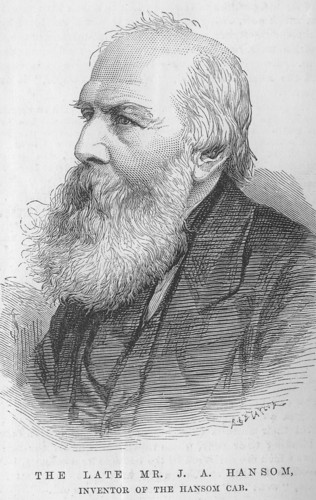
Joseph Aloysius Hansom was a British architect working principally in the Gothic Revival style. He invented the Hansom cab and founded the eminent architectural journal, The Builder, in 1843.

The National Portrait Gallery (NPG) is an art gallery in London that houses a collection of portraits of historically important and famous British people. When it opened in 1856, it was arguably the first national public gallery in the world that was dedicated to portraits. The gallery moved in 1896 to its current site at St Martin's Place, off Trafalgar Square, and adjoining the National Gallery. It has been expanded twice since then. The National Portrait Gallery also has regional outposts at Beningbrough Hall in Yorkshire and Montacute House in Somerset. It is unconnected to the Scottish National Portrait Gallery in Edinburgh, with which its remit overlaps. The gallery is a non-departmental public body sponsored by the Department for Digital, Culture, Media and Sport.
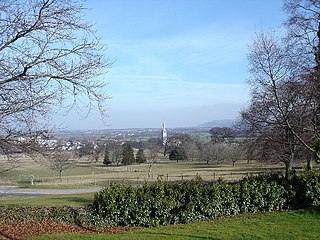
Bodelwyddan is a village, electoral ward and community in Denbighshire, Wales, approximately 5 miles (8 km) South of Rhyl. The Parish includes several smaller hamlets such as Marli and Pengwern.
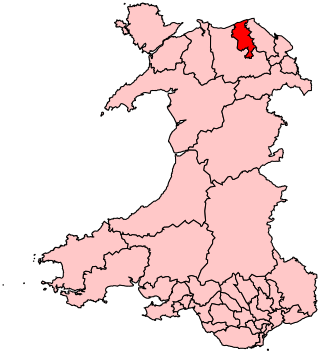
The Vale of Clwyd is a constituency of the House of Commons of the UK Parliament created in 1997 and represented since 2019 by James Davies of the Conservative Party. As with all extant seats its electorate elect one Member of Parliament (MP) by the first past the post system at least every five years.

Hafodunos Hall is a Gothic revival house located near the village of Llangernyw in Wales. Designed by Sir George Gilbert Scott, it was built between 1861 and 1866 for Henry Robertson Sandbach, replacing a house that had been built in 1674.

St Margaret's Church, Bodelwyddan, is a Decorated Gothic Style parish church in the lower Vale of Clwyd in Denbighshire, Wales and is visible for many miles because its spire rises to 202 feet. It lies just off the A55 trunk road.

The Williams-Wynn Baronetcy, of Gray's Inn in the County of Middlesex was created in the Baronetage of England on 6 July 1688 for William Williams, a prominent Welsh politician and lawyer from Anglesey, Wales. A member of the family, Sir Watkin, became one of the richest men in Britain.

Kinmel Hall is a large country mansion within Kimnel Park near the village of St. George, close to the coastal town of Abergele, in Conwy county borough, Wales. The hall, the third building on the site, was completed in the mid 19th century for the family of a Welsh mining magnate. In 1929, the property ceased being a private residence; it has since been used as a boys' school, health spa, girls' school, wartime hospital, conference centre and hotel.
Florence Lindley was the first headmistress of Lowther College, a private girls' school set up in 1896 in Lytham St. Annes, Lancashire. In 1920 she oversaw the college's move to Bodelwyddan Castle in Denbighshire, where she remained as headmistress until 1927, when the school was sold to Allied Schools. Lindley then moved to Kinmel Hall, a few miles away, where she converted the building into a 'rheuma spa', for the treatment of people with rheumatism.

Studley Castle is a 19th-century country house at Studley, Warwickshire, England.
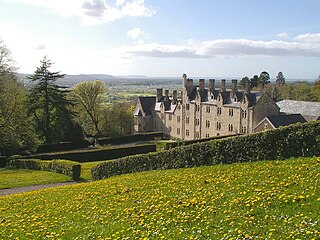
St Beuno's Jesuit Spirituality Centre, known locally as St Beuno's College, is a spirituality and retreat centre in Tremeirchion, Denbighshire, Wales. It was built in 1847 by the Jesuits, as a theology college. During the 1870s the Victorian poet Gerard Manley Hopkins studied there. Since 1980, it has been a spirituality and retreat centre. Standing on the Clwydian Range, the front of the building faces west towards Snowdonia and overlooks the Vale of Clwyd. The building became a Grade II* listed building and a Welsh Historic Monument in 2002.
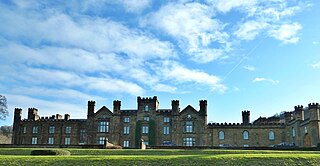
Wilton Castle is an early 19th-century mansion, built on the site of a medieval castle, now converted into residential apartments, situated at Wilton, in Redcar and Cleveland, North Yorkshire, England. It is a Grade II listed building.
The office of High Sheriff of Clwyd was established in 1974 as part of the creation of the county of Clwyd in Wales following the Local Government Act 1972, and effectively replaced the shrievalties of the amalgamated counties of Flintshire and Denbighshire.

Benjamin Gummow was an architect who worked from Ruabon near Wrexham in Wales. He worked almost exclusively for Sir Watkin Williams Wynn of Wynnstay, Ruabon and the Grosvenor family of Eaton Hall near Chester. He was born in St Endellion in Cornwall in 1766 and died at Ruabon in March 1844.
Warner Leisure Hotels is a hospitality company owning 14 country and coastal properties around the UK in North Wales, Somerset, Herefordshire, Berkshire, North Yorkshire, Nottinghamshire, Isle of Wight, Suffolk, Hampshire and Warwickshire. Since 1994, its hotels have been adult-only.

Architecture of Wales is an overview of architecture in Wales from the medieval period to the present day, excluding castles and fortifications, ecclesiastical architecture and industrial architecture. It covers the history of domestic, commercial, and administrative architecture.
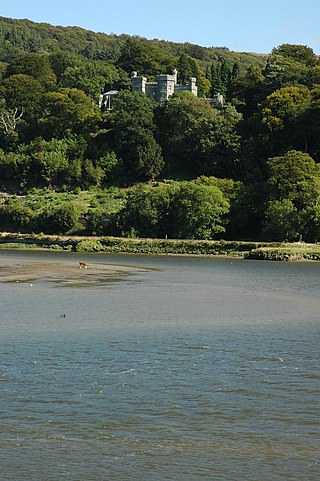
Glandyfi Castle in Glandyfi, Ceredigion, Wales, is a mock castle dating from the early 19th century. It was built for George Jeffreys, a barrister and High Sheriff of Cardiganshire, in around 1819.



































